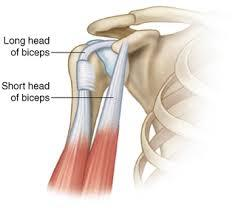Many different muscles, bones, and ligaments that comprise the shoulder. The bones that make up the shoulder joint are the scapula, clavicle and humerus. It is important to remember that every muscle that passes over a joint plays a role in moving and stabilizing that joint. The rotator cuff muscles are primarily regarded as having an imperative function in shoulder stability but lesser-known is the significance of the long head of the triceps and biceps.

The primary action of the triceps is to extend the lower arm at the point of the elbow and they are often only known for this action. However, if you look carefully at the long head of the triceps, you can identify that the point of origin falls on the scapula, causing it to play a role in stabilizing the shoulder as well. The long head of the triceps originates right above the connection between the humerus and the glenoid fossa in a spot called the infraglenoid tubercle. The origin of the long head of the triceps is key in understanding why an undiagnosed triceps injury may lead to a shoulder problem down the road.
Pain that comes from a certain region of the body, without the appearance of acute trauma, is often the residual effect of compensation. Due to the triceps origin at the shoulder and insertion below the elbow, an elbow injury can cause substantial inhibition and pain in the shoulder.

Another muscle that helps to stabilize the shoulder is the long head of the biceps brachii. The biceps brachii is the opposing muscle to the triceps. The long head of the biceps is involved in shoulder stability due to its point of origin being located in the shoulder at the supraglenoid tubercle. The long head of the triceps prevents the humerus from moving too far posteriorly with the force produced by different muscles such as the posterior deltoid and infraspinatus. Meanwhile, the biceps contribute to the anterior stability of the humerus along with muscles such as pectoralis major and subscapularis.
Taking a deeper look into shoulder stability illuminates our understanding that tissue damage is not just localized to where a patient may feel pain. An issue may arise in one location but cause inhibition somewhere else triggering a compensative injury to transpire. Furthermore, understanding the role these overlooked muscles play in shoulder stability helps us to identify dysfunction in these areas and rehabilitate them effectively.
More to come on how to treat problems with the long head triceps and biceps!
Written by Matt O’Brien (Personal Trainer and Bachelor of Kinesiology Student).
Edited by Sarah Tringale (Traditional Chinese Medicine Practitioner Candidate).
